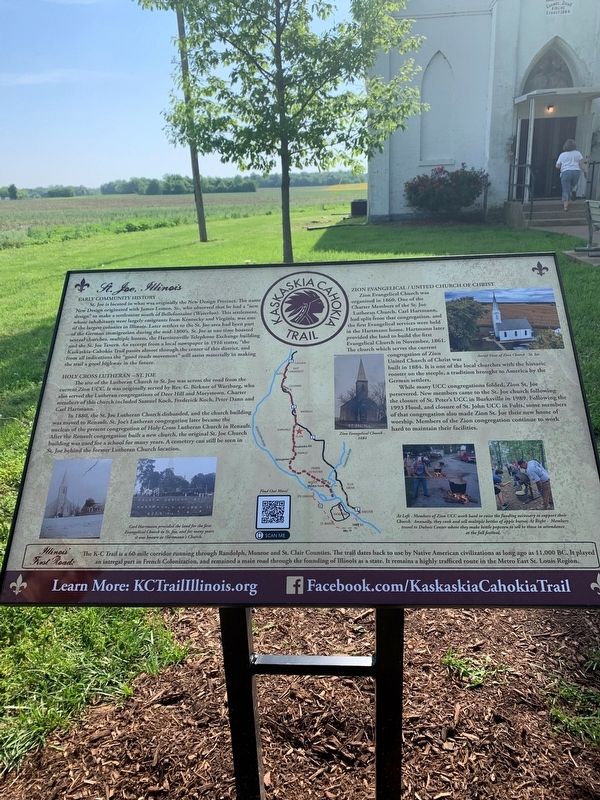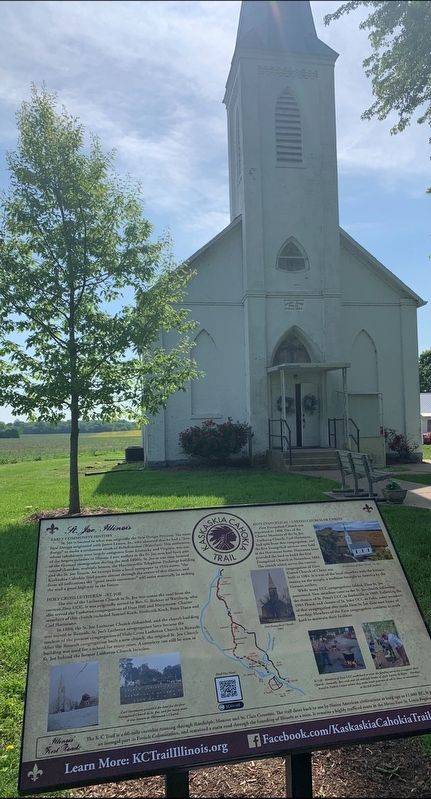St. Joe in Monroe County, Illinois — The American Midwest (Great Lakes)
St. Joe, Illinois
Kaskaskia-Cahokia Trail
— ⚜️ —
Early Community History
St. Joe is located in what was originally the New Design Precinct. The name New Design originated with James Lemen, Sr., who observed that he had a "new design” to make a settlement south of Bellefontaine (Waterloo). This settlement, whose inhabitants were largely emigrants from Kentucky and Virginia, was one of the largest colonies in Illinois. Later settlers to the St. Joe area had been part of the German immigration during the mid-1800's. St. Joe at one time boasted several churches, multiple homes, the Harrisonville Telephone Exchange building and the St. Joe Tavern. An excerpt from a local newspaper in 1916 states, "the Kaskaskia-Cahokia Trail passes almost through the center of this district, and from all indications the "good roads movement” will assist materially in making the trail a good highway in the future.
Holy Cross Lutheran - St. Joe
The site of the Lutheran Church in St. Joe was across the road from the current Zion UCC. It was originally served by Rev. G. Birkner of Wartburg, who also served the Lutheran congregations of Deer Hill and Maeystown. Charter members of this church included Samuel Koch, Frederick Koch, Peter Dann and Carl Hartmann.
In 1880, the St. Joe Lutheran Church disbanded, and the church building was moved to Renault. St. Joe's Lutheran congregation later became the nucleus of the present congregation of Holy Cross Lutheran Church in Renault. After the Renault congregation built a new church, the original St. Joe Church building was used for a school for many years. A cemetery can still be seen in St. Joe behind the former Lutheran Church location.
Zion Evangelical / United Church of Christ
Zion Evangelical Church was organized in 1860. One of the Charter Members of the St. Joe Lutheran Church, Carl Hartmann had split from that congregation, and the first Evangelical services were held in the Hartmann home. Hartmann later provided the land to build the first Evangelical Church in November, 1861. The church which serves the current congregation of Zion United Church of Christ was built in 1884. It is one of the local churches with the historic rooster on the steeple, a tradition brought to America by the German settlers.
While many UCC congregations folded, Zion St. Joe persevered. New members came to the St. Joe church following the closure of St. Peter's UCC in Burksville in 1989, Following the 1993 Flood, and closure of St. John UCC in Fults, some members of that congregation also made Zion St. Joe their new home of worship. Members of the Zion congregation continue to work hard to maintain their facilities.
Erected 2022 by Kaskaskia-Cahokia Trail Coalition.
Topics. This historical marker is listed in these topic lists: Churches & Religion • Settlements & Settlers. A significant historical year for this entry is 1800.
Location. 38° 13.91′ N, 90° 9.321′ W. Marker is in St. Joe, Illinois, in Monroe County. Marker is on Kaskaskia Road (County Road 1) half a mile east of LL Road, on the right when traveling north. On the grounds of the Zion United Church of Christ. Touch for map. Marker is at or near this postal address: 4202 Kaskaskia Rd, Waterloo IL 62298, United States of America. Touch for directions.
Other nearby markers. At least 8 other markers are within 5 miles of this marker, measured as the crow flies. Holy Cross Lutheran Cemetery (within shouting distance of this marker); Armin Henry Krueger (approx. 1.1 miles away); Historic Conservation at Foglepole (approx. 2.4 miles away); Site of the First English Speaking School in Illinois (approx. 2.8 miles away); Storment Family History (approx. 3 miles away); Tipton, Illinois (approx. 3.2 miles away); James Lemen (approx. 4 miles away); St. John's First Church (approx. 4.1 miles away).
Credits. This page was last revised on May 16, 2022. It was originally submitted on May 16, 2022, by Thomas Smith of Waterloo, Ill. This page has been viewed 194 times since then and 36 times this year. Photos: 1, 2. submitted on May 16, 2022, by Thomas Smith of Waterloo, Ill. • Devry Becker Jones was the editor who published this page.

